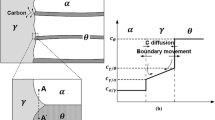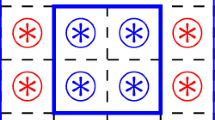Abstract
A cellular automaton (CA) model is proposed that simulates the structural evolution of a nonstoichiometric SiO m (m < 2) layer with a thickness of 3–30 nm, involving the formation of silicon nanoclusters during thermal annealing at temperatures within 900–1200°C. The model does not take into account the crystalline or amorphous structure of the nanoclusters. The three-dimensional CA model implemented on a cubic 0.54-nm mesh grid by the SoftCAM software is synchronous, does not use the Margolus block neighborhood, and is open to the incorporation of ab initio calculations for Si x O y clusters. The state of the CA cell is determined by three variables (x, y, z), which take discrete values 0, 1, 2, …, and 255 (corresponding to the numbers of silicon and oxygen atoms and conditional vacancies in the cell), and the fourth variable δ, which takes values 0, 1, and 2, indicating that the given cell belongs to a silicon nanocluster, SiO x matrix, or their interface. The local transition rules are defined based on the following considerations: (i) each cell is characterized by a scalar “free energy” dependent only on the cell state (analogous to thermodynamic potentials); (ii) this free energy is defined as the sum of three components: internal energy U(x, y), elastic energy G(z), and surface energy E(δ); and (iii) the exchange of matter between the cells is determined by probabilities dependent on the difference of the free energies according to the Fermi–Dirac relation. The model traces the evolution of the total number of clusters, their average size, and the average distance between them. The results of the numerical simulation are consistent with the published experimental data.
Similar content being viewed by others
References
Cooks, M., Flash fast forward to quantum dot memory, Semicond. Today. Compd. Adv. Silicon, 2008, vol. 3, no. 5, pp. 45–49.
Wang, M., Anopchenko, A., Marconi, A., Moser, E., Prezioso, S., Pavesi, L., Pucker, G., Bellutti, P., and Vanzetti, L., Light emitting devices based on nanocrystalline-silicon multilayer structure, Physica E, 2009, vol. 41, pp. 912–915.
Kirchartz, T., Seino, K., Wagner, J.-M., Rau, U., and Bechstedt, F., Efficiency limits of Si/SiO2 quantum well solar cells from first-principles calculations, J. Appl. Phys., 2009, vol. 105, p. 104511.
Garrido, B.F., Lopez, M., Garsia, C., PerezRodrigues, A., Morante, J.R., Bonafos, C., Carrada, M., and Claverie, A., Influence of average size and interface passivation on the spectral emission of Si nanocrystals embedded in SiO2, J. Appl. Phys., 2002, vol. 91, no. 2, pp. 798–807.
Pavesi, L. and Turan, R., Silicon Nanocrystals: Fundamentals, Synthesis, and Applications, Wienheim: Wiley-VCH, 2010.
Dan’ko, V.A., Indutnyi, I.E., Lysenko, V.S., Maidanchua, I.Yu., Min’ko, V.I., Nazarov, A.N., Tkachenko, A.S., and Shepelyavyi, P.E., Kinetics of structural and phase transformations in thin SiOx films in the course of a rapid thermal annealing, Semiconductors, 2005, vol. 39, no. 10, pp. 1197–1203.
Emi, K. and Takashi, U., Evolution process of luminescent Si nanostructures in annealed SiOx films probed by photoconductivity measurements, Appl. Phys. Lett., 2007, vol. 91, no. 4, p. 041910.
Oono, Y. and Kohmoto, M., Discrete model of chemical turbulence, Phys. Rev. Lett., 1985, vol. 55, no. 27, pp. 2927–2931.
Karpov, A.N., Mikhant’ev, E.A., Usenkov, S.V., and Shvarts, N.L., Monte-Carlo simulation of silicon nanocluster formation process in silicon dioxyde, Izv. Vyssh. Uchebn. Zaved., Mater. Elektron. Tekh., 2012, no. 1, pp. 41–47.
Spicher, A., Fatès, N., and Simonin, O., Translating discrete multi-agents models into cellular automata, application to diffusion-limited aggregation, in Proceedings of the International Conference on Agents and Artificial Intelligence ICAART 2009, Commun. Comput. Inform. Sci., 2010, vol. 67, pp. 270–282. https://hal.inria.
Five Cellular Automata: Diffusion-Limited Aggregation. http://www.hermetic.ch/pca/da.htm
Roma, G., Limoge, Y., and Martin-Samos, L., Oxygen and silicon self-diffusion in quartz and silica: the contribution of first principles calculations, Def. Diff. Forum, 2006, vols. 258–260, pp. 542–553.
Sarom, Sok et al., Molecular dynamic simulation of SixOy clusters using a classical potential, in Proceedings of the 227th Amer. Chem. Soc. (ACS) National Meeting, Anaheim, CA, March 28–Apr. 1, 2004.
Zhang, R.Q., Zhao, M.W., and Lee, S.T., Silicon monoxide clusters: the favorable precursors for forming silicon nanostructures, Phys. Rev. Lett., 2004, vol. 93, no. 9, pp. 095503-1–4.
Chu, T.S., Zhang, R.Q., and Cheung, H.F., Geometric and electronic structures of silicon oxide clusters, J. Phys. Chem. B, 2001, vol. 105, pp. 1705–1709.
Terekhov, V.A., Turishchev, S.Yu., Kashkarov, V.M., Domashevskaya, E.P., Mikhailov, A.N., and Tetel’baum, D.I., Silicon nanocrystals in SiO2 matrix obtained by ion implantation under cyclic dose accumulation, Phys. E: Low-Dim. Syst. Nanostruct., 2007, vol. 38, nos. 1–2, pp. 16–20.
Author information
Authors and Affiliations
Corresponding author
Additional information
Original Russian Text © G.Ya. Krasnikov, N.A. Zaitsev, I.V. Matyushkin, S.V. Korobov, 2014, published in Izvestiya Vysshikh Uchebnykh Zavedenii. Materialy Elektronnoi Tekhniki, 2014, No. 2, pp. 109–115.
Rights and permissions
About this article
Cite this article
Krasnikov, G.Y., Zaitsev, N.A., Matyushkin, I.V. et al. Cellular automaton model of phase separation during annealing of nonstoichiometric silicon oxide layers. Russ Microelectron 44, 523–530 (2015). https://doi.org/10.1134/S1063739715080168
Received:
Published:
Issue Date:
DOI: https://doi.org/10.1134/S1063739715080168




